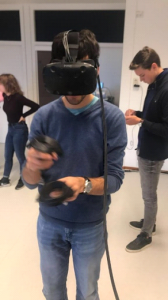The course of this Friday was yet again very different from all the previous ones. I sat down, grabbed my stuff and was ready to go. I knew we would have a lecture from Sven Dupré, and when looking at the course manual it said: Re-enactment with Sven Dupré.

This confused me a bit, because wasn’t quite sure if he would show up disguised as a Roman centurion or just an ordinary lecture. It surely wasn’t the first, however, it certainly wasn’t the latter. Prior to the course, we had been instructed to bring drawing and painting attributes. We collectively gathered a lot of stuff to draw or create a piece of art with. However, Ivar naturally had to outdo us all by bringing and installing a VR headset, giving us the opportunity to draw in ‘Virtual Reality’. After all this, we still don’t know what the lecture was about. Mr. Dupré started talking and explaining what he does and meanwhile Ivar was still busy setting up his toys, which was distracting me just a little bit. But while I was distracted, Sven explained what he is doing on a daily basis. ‘Artechne’, the reconstruction, ‘replication’ (you can’t relive the past) and the re-enactment of for example recipes from the 18th century. Artechne is all about the technique in the arts. It firstly uses text as a source, this in the form of recipes which they will try to reconstruct. Sometimes even using modern techniques such as ‘3D printing’. The reconstruction and following of recipes is for instance to discover how an object feels or what it takes to make it. The next part of artechne is de collaboration during the process with experts with all a different expertise. Thirdly the dynamic aspect, the varying skills, senses and even the order of the process. Finally, sites matters, where was the object made? In what kind of environment?
Those four points are briefly what the lecture of Sven was about. Then we got to the ‘drawing’ part of the course. We were given the assignment to interpret a recipe for wax dating from the 18th century for instance, the surroundings of where the object was crafted. This is not mentioned in the instructions, but could be of great importance while reproducing and following instructions. We were divided into two groups, one got to use the headset and the others all the other materials that were gathered. I was quite impressed by the end result of the other group. They used paint very cleverly to make a three dimensional wax sticking out of the paper using a lot of paint. Ironically, everything made in VR was in 3D, but you weren’t able to actually touch it. What was done by the person in virtual reality, would be displayed on a computer and looked fairly ordinary. However, when trying it myself, I was flabbergasted by it. The experience was awesome and quite unimaginable. After having finished the assignment and the lecture, we thanked Sven and went on to work on the prototypes for the final hour. This was mostly installing software to be able to program the application. Finally, the course came to an end. I had to leave unfortunately but the others went on to play games in VR. Overall, it was a really educational, interesting and certainly fun course.
By David Struch